Last Updated on April 8, 2022 by Grow with Bovees
When it comes to comparing Crabgrass vs Bermuda grass, there are plenty of similarities:
- They both grow really quickly
- They both can overwhelm and bully other plants
- They’re both invasive and can take over your lawn if not controlled
Sounds like we’re talking about two common weeds, right?
Wrong, we’re talking about Bermuda grass and crab grass!
But what if we were to tell you that one of these grass species can make for a lovely thick, beautiful, luscious lawn if you control it properly?
It’s almost unbelievable but completely true.
Read on to find out which variety to choose and how to best use it to create a perfect lawn.
We’ll also look at how to control the unwanted grass in your garden with some useful tips and tricks.
Is Bermuda Grass the Same as Crabgrass?
In short – No!
As we pointed out in the introduction, they both have some similar characteristics, but there is one type you do not want to use for your turf. Ever. See our pictures of crabgrass and bermuda grass below.
What Are the Differences?
If you didn’t know already, Crab grass is a weed that no one wants as part of their lawn.
Bermuda grass, on the other hand, can make for a lovely thick and highly desirable lawn grass if cared for properly.
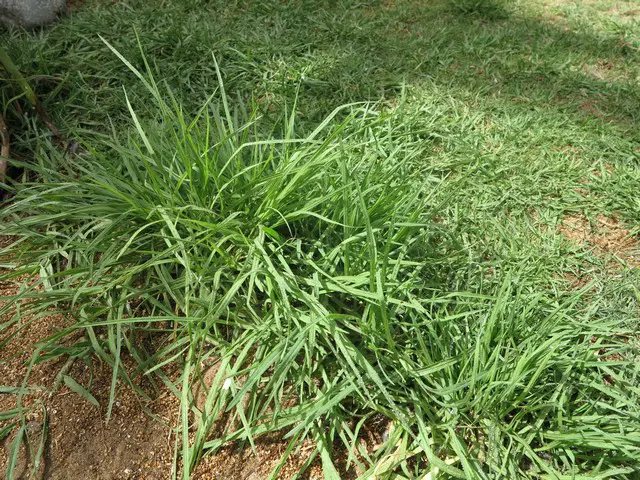
Hairy crab grass grows fast, looks ugly, and feels very rough to the touch, not the best thing to walk on bare-footed! Bermuda grass, however, feels truly soft and luscious under your feet and is just beyond comparison.
When it comes to climate and soil type, Crab grass will grow almost anywhere, it really doesn’t care if it’s hot and dry or cool and wet, crab grass thrives in most conditions during the growing season, although it especially likes sandy, compact soil.
Bermuda Grass, on the other hand, is a warm season grass species from tropical and subtropical areas, so it likes the southern United States.
As far as we can tell, bermuda grass became established in this area sometime in the early 1800s and once it got a foothold, it continued to thrive.
It’s quite sensitive to colder weather though, more so than other warm season grasses such as Zoysia and of course much more than cool-season varieties like Fescue.
For this reason, bermuda grass can’t be used very far north, so it is a truly ‘southern state only’ grass. It also needs full direct sunlight to thrive and soil with excellent drainage.
The extensive root system of bermuda grass will usually stay within 6 inches of the soil surface, although it is known that it establishes deep roots down to as much as 6 feet if it needs to!
This is one reason why bermuda grass tolerates a high degree of environmental stress and is often used as turf in areas of heavy foot traffic as well as feeding areas for livestock.
How Crab Grass Spreads and Grows
The two most common species of crabgrass family of weed grasses found in North America are either the smooth crab grass or the large crab grass varieties.
Both of these are an annual plant and aggressive weeds that spread unchecked when the weather gets warmer from seed deposited the previous year.
The plant germinates, sprouts, and dies in a single season, being killed off by the first frosts of the fall. However, during the summer, the crabgrass seed heads will have carpeted your entire lawn with thousands of tiny crabgrass seeds just waiting to get started again the following year.
Bermuda Grass and How It Thrives & Spreads
As we know this grass is a warm-season variety that is very tolerant to heat, humidity, drought, and salt as well, making it perfect for hot southern coastal areas.
Bermuda grass is a perennial grass that actively grows from late spring and all the way through summer before becoming dormant again in the fall.
Unlike crabgrass, Bermuda Grass has smooth leaves with a medium texture and fine hairs at the base of the leaf blades that give it such a lush feeling on bare feet.
The leaves are a lovely dark green color during the growing season and if you live in a frostless area, will stay green the whole year. In other regions, it will turn brown after the first frost and stay that way through the winter until the next spring.
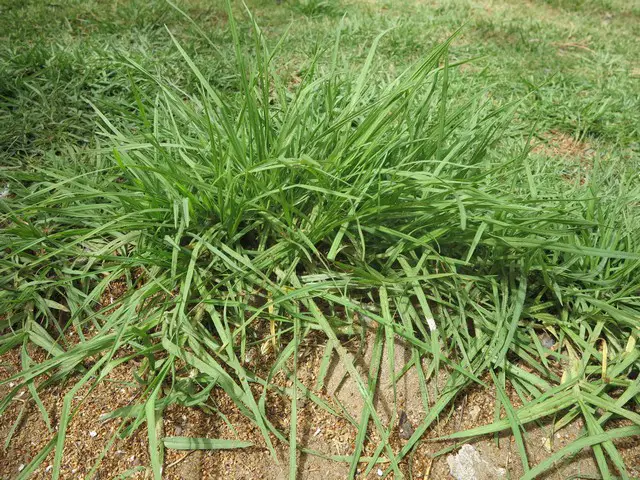
We’ve talked about how crabgrass spreads mainly by seed, but in contrast, the way bermuda grass spreads is by ‘creeping’. And we’re not talking slow and steady here, this one can get going very quickly with aggressive growth habits!
It spreads rapidly via both the underground rhizomes below the ground and stolons above, doing a great job of filling in turf patches and bare spots in the process!
That means that unless you contain it, then it will continue to creep outside of the Bermudagrass lawn area and invade flower beds, sidewalks, driveways, and pretty much anywhere you don’t actually want it.
That’s when bermuda grass becomes a ‘weed’ that’s as much of a nuisance as the crab variety.
Why Grow a Bermuda Grass Lawn?
If you live in the right climate and are prepared for the extra maintenance of a fast-growing lawn, Bermuda Grass is definitely a worthy choice of turf grass.
It can withstand heat and is drought tolerant plus it recovers very quickly so is ideal for use in heavy traffic areas and sporting applications.
This makes it very popular with homeowners looking for a lawn turf that will keep up with foot traffic stress, as well as golf courses and athletics fields that need something harder wearing than common lawn grass.
So what’s the downside?
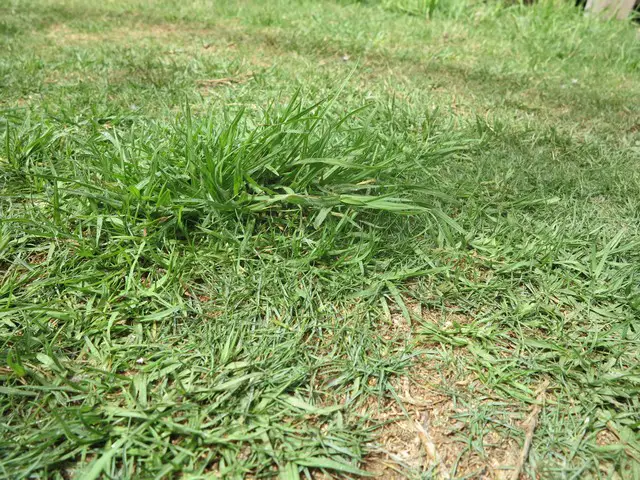
Maintaining Bermudagrass Lawns
There’s no getting away from it, this lawn grass is high maintenance!
As it’s such an aggressive grower it will need regular feeding every month during the growing season. It will also need mowing twice a week to keep it at the ideal length with the mower blade set at 1 to 1 1/2 inches for home yard lawns.
During long periods of drought, the Bermuda grass will go dormant and you end up with brown grass, so if you want it to stay green during the hot and dry summer months, it will need frequent watering with several inches of water on a regular basis.
Whilst it does have an aggressive growth habit, this only becomes a problem when it’s not controlled. This means installing proper lawn edging and keeping on top of any spread to unwanted areas.
Remember, it’s an invasive species and once the unwanted grass gets into your flower beds or pathways, you’ll have a job on your hands to eradicate it!
How to Start a Bermuda Grass Lawn
Most new lawns of this type are grown from sod or turf, but it is possible to start it entirely from seed.
This gives you a few options when planning out your new lawn but also has a great advantage of being able to fill in bare spots just by scattering the same type of grass seed.
As it sprouts, the growth pattern will mean that it creeps into the surrounding grass and before you know it the patch will completely disappear.
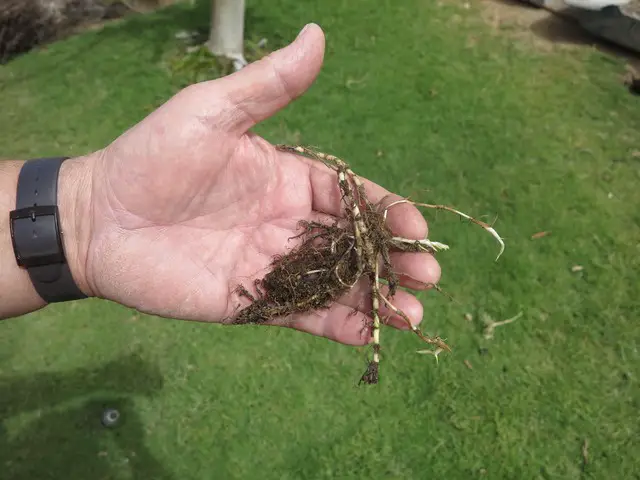
Unlike some lawn grass types, it’s best planted in the spring after the final frosts have finished, just when this type of warm-season grass is coming out of its dormancy and entering the prime growth season.
You can also overseed a Bermuda lawn at this time rather than doing it in the fall like many other varieties.
Pros and Cons of Common Bermuda Grass
Pros:
- Can easily withstand heavy foot traffic
- Recuperates very quickly from stress
- Very good drought and heat tolerance compared to other grasses
- Ability to fill in bare spots quickly
- Finer varieties are perfect for soft bladed turf and luscious lawns
Cons
- High maintenance with an aggressive growth rate
- Lots of water and needs fertilization during peak growth
- Can be invasive if not controlled
What is Bad About Crabgrass?
Well, pretty much everything really!
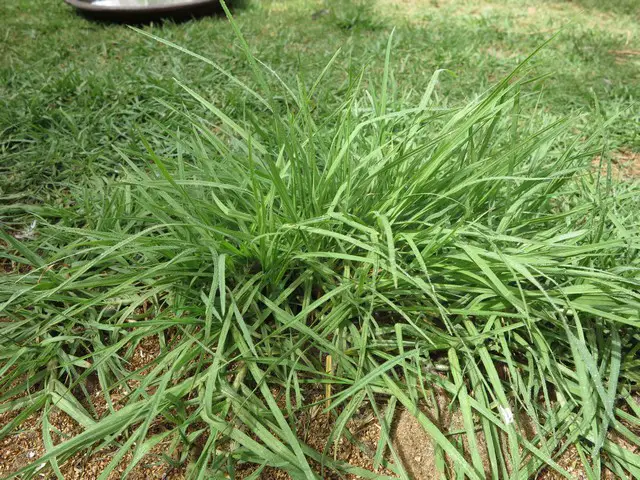
Although of course, it’s not actually ‘bad’ in a poisonous or dangerous kind of way, there is nothing good about it either.
As an annual grass weed, crabgrass has excessive growth rates and is one of the most frustrating weeds to try and get rid of.
Just as spring comes along and all the new plants come to life, so does this invader of lawns, flower beds, farmland, and turfgrass.
It rapidly grows in dense, unsightly clumps and spreads widely through nodes on the stems that will take root wherever they touch the ground. That’s as well as new plants that emerge from seeds deposited on the ground over the years.
Did you know the ungerminated grass seed of this weed can lay dormant for up to 30 years before finally sprouting? No wonder they’re such a pain to get rid of!
And with a single mature plant able to produce 150,000 crab grass seeds in a single season you may feel you’re fighting a losing battle with your weed control.
Luckily the roots are easy to pull out as they are fairly shallow, but that’s about the only good thing we can find to say about them!
How to Prevent or Control Crabgrass
So we’ve established that you really don’t want this as a lawn, but how do you get rid of it?
Smooth crabgrass is especially fond of unhealthy lawns that are under fertilized, do not have enough water, or don’t drain well. That may sound as though it’s just poorly maintained lawns that will be plagued by this, but in reality, even a lawn that’s looked after can still suffer from an infestation.
The best way is to prevent it from taking hold in the first place.
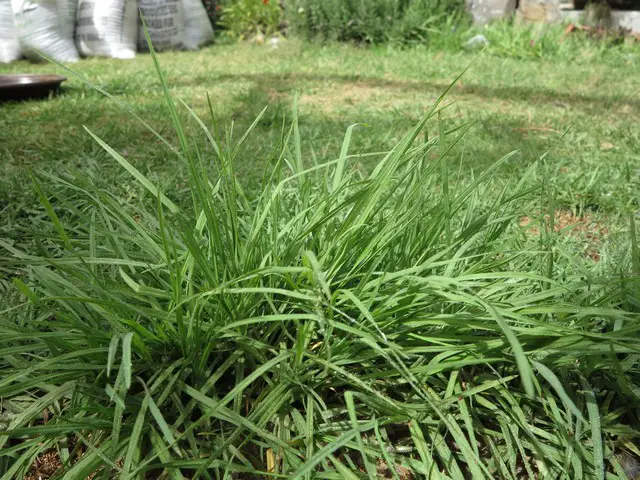
A Healthy Lawn to Tackle Crabgrass
So the first line of defense is to look after your patch of grass in the best way you can. The healthier it is with desirable grasses the less susceptible it will be to crabgrass and other lawn weeds.
Keep it well-fed and watered, and dethatch it when needed to remove dead material. It will definitely benefit from a good core aeration every season as well.
Frequent mowing also helps control weed growth.
The real key to making this method successful is to give your turf the best possible growing conditions so that it works in your favor with exceptional lawn care. Make sure you are using the best type of grass for your region as well.
For instance, if you live in a southern state, a healthy Bermuda Grass lawn will work very well as an effective control as we will discuss later.
Combine all this, and it will ensure your grass grows luscious and thick, choking weeds, such as clover, and make them easier to spot if they do rear their ugly head.
Using a Pre-Emergent Herbicide
If your lawn has already been taken prisoner by crabgrasses in the past year, the best way to stop it is to kill it before it sprouts the following spring.
To do that, you will need to use something called a pre-emergent herbicide.
As the name suggests, this needs to be applied before the grassy weeds emerge, but you don’t want to put it down too early or it will lose its effectiveness too soon.
The best way to time it is to either use a soil thermometer, so you can monitor the temperature of the soil (you’re looking for when the soil reaches a temperature of 55 degrees) or to look out for the first forsythia blossoms to appear.
As soon as they come out, it’s time to put down the herbicide product. If the crabgrass has appeared already then it’s too late so timing is everything!
As a rough guide, this will be between mid-February and mid-March depending on where you live. A second application is usually required around 6 weeks later.
Some FAQs About Bermuda grass vs Crabgrass
Will Bermudagrass choke out crabgrass?
As Bermuda grass is considered a weed by some people, it should be no surprise that when cultivated properly, it can overpower crabgrass and other weeds on its own. Just make sure to look after it properly as we covered earlier and you should see some great results.
What kills crabgrass in Bermuda grass?
You will need to find a weed killer product that has been designed to target crabgrass specifically rather than other weeds as well, whilst not harming the common Bermuda Grass.
These products are known as a selective post-emergent herbicide and should be safe to use on lawns with most types but make sure you read the label and follow the manufacturers’ instructions.
As we mentioned above, a pre-emergent herbicide is also a good way to stop the crabgrass weed invading your yard.
How can you tell the difference between bermudagrass and crabgrass?
Crabgrass will grow in dense clumps with long, dark leaves rather than the typically uniform coverage of a Bermuda grass lawn. It’s usually pretty easy to spot.
You may need to refer to some Bermuda grass pictures if you are struggling to identify them.
Final Thoughts on Bermuda Grass and Crabgrass
Whilst many people still think of Bermuda Grass pictured as a weed, that’s only true if it’s not controlled. When properly cultivated it can make a beautiful turf that’s both good-looking and hard-wearing. If not kept in check, its shallow roots will spread like crazy.
These lawns are drought resistant, can cope with foot traffic stress, and are an excellent choice for homeowners.
They have no cold weather hardiness though and are only suitable for growing in warmer climates that don’t suffer from cool soil temperatures.
Crabgrasses, on the other hand, definitely are weeds and do not make up a decent turf. Eradicate them as soon as possible if you spot them in your lawn or anywhere around your yard.
